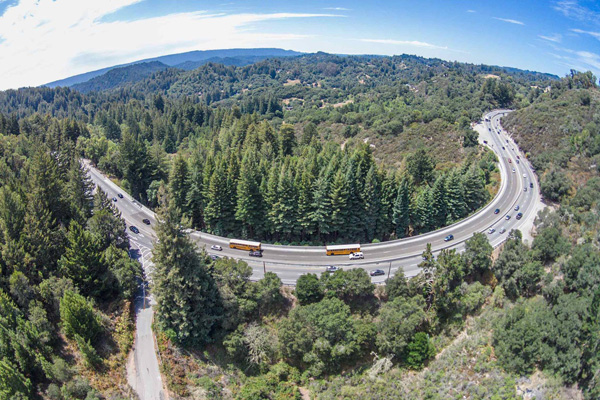Santa Cruz in the 1950s
By Edward G. Brooks
Before you discuss Santa Cruz as a place for the hippie movement in the 60’s it is helpful to know something about Santa Cruz in the years preceding.
Santa Cruz was a magic place in the 50’s but was only just becoming aware of it. Santa Cruz was mainly known as a place to retire to, and a beach resort. The key to the changes in the County was Highway 17.
When I was a kid in Felton, 1956 or so, my family would read the Santa Cruz Sentinel on Sunday morning for the accident accounts on Highway 17 on Saturday night. Fatal accidents were reported weekly on Laurel Curve. Laurel Curve is still dangerous. I recall reports, perhaps apocryphal, of hillbillies living in the gulches and canyons around Laurel Curve who would wait for the cars to crash down off Highway 17, and then would loot the bodies of the victims. In about 1958 I knew a young man named Randolph who was in a car that came down Highway 17 past Pasatiempo southbound, missed a curve, and went into some logs that had been put in the median, butt ends toward traffic. He came over the front seat and thru the windshield. It was the usual 50’s traffic accident, completely preventable by today’s standards. Randolph got grafts for skin taken off his face. In those years there were no median barriers. Even today the road is full of sharp curves that tend to send cars toward the oncoming traffic. Some knowledgeable 17 commuters will try to stay in the fast lane, so they can get a preview of stalled hazards around the next bend and have time to stop or swerve. Just a few weeks ago I had a near accident southbound 17 when I was in the number 1 lane south of Redwood Estates. A pickup pulling a long horse trailer, who had not been traveling in the fast lane, very suddenly pulled in front of me. He had entered a right curve and came on a Teresi heavy truck-trailer rig from Lodi stopped in the number 2 lane. I hit my brakes hard and watched the horse trailer, trailing the truck, swing across at a few feet and 50 miles per hour. Times haven’t changed much on Highway 17 in some ways.
Head-ons were common in the 50’s and 60’s, probably later, because there were no barriers. Some of the turns seemed to be designed to send a car across the center line into oncoming traffic. Anyone can drive Highway 17 today and see that the road hasn’t changed much, although life-saving median barriers have been added, the curves have been eased some, and the lanes widened a little. Cars in the 60’s and 70’s were sleds, uncontrollable above about 60 miles an hour on a curve. I can remember entering the curve on Highway 17 northbound, which is now just past the first Scotts Valley turn-off, at about 65 or 70 in a ’59 Pontiac. It was and still is a sweeping left curve, which is easily handled by cars today. Then, I went into a dry pavement skid that came within a hair of putting me into a 360 and probably rolling. The trip to Santa Cruz from the Valley or the Bay Area was not a freeway cruise in the 50’s or beyond. The freeway system as we now know it didn’t exist. The trip was a series of a few fast roads which turned into secondary roads. There were sections that were more or less freeways, like the Nimitz coming down to Hayward from Oakland. But this turned into old State Highways like the Cupertino road and other roads that slowly took you to Highway 17. The dangers of Highway 17 and the time-consuming commute of the roads that led to it isolated Santa Cruz into the 50’s and 60’s, and beyond, from the rest of the Bay Area.
To live in Santa Cruz County in those years was to accept the idea that you were engaged in a trade-off, between the magic of the Monterey Bay, and the economic survivability of the Santa Clara Valley and the Bay Area. The Santa Cruz Sentinel “help wanted” ad columns were sometimes shorter than the “work wanted” columns. There was something bigger that was in the minds of young Santa Cruzans. I can recall hearing it said more than once, “Where do you go, when you’re already in the best place there is?” Kids right out of high school were aware of the problem of being on the Edge, to use a later metaphor. Everyone knew that jobs and money were “over the hill”, in the Santa Clara Valley. But no one wanted to leave, if they could help it.
Santa Cruz was a magic place, waiting for Highway 17 and the freeways to be improved, and money from Cabrillo College and the University of California to come in. When would its magic become part of its general awareness? When would it end? Stay tuned.







